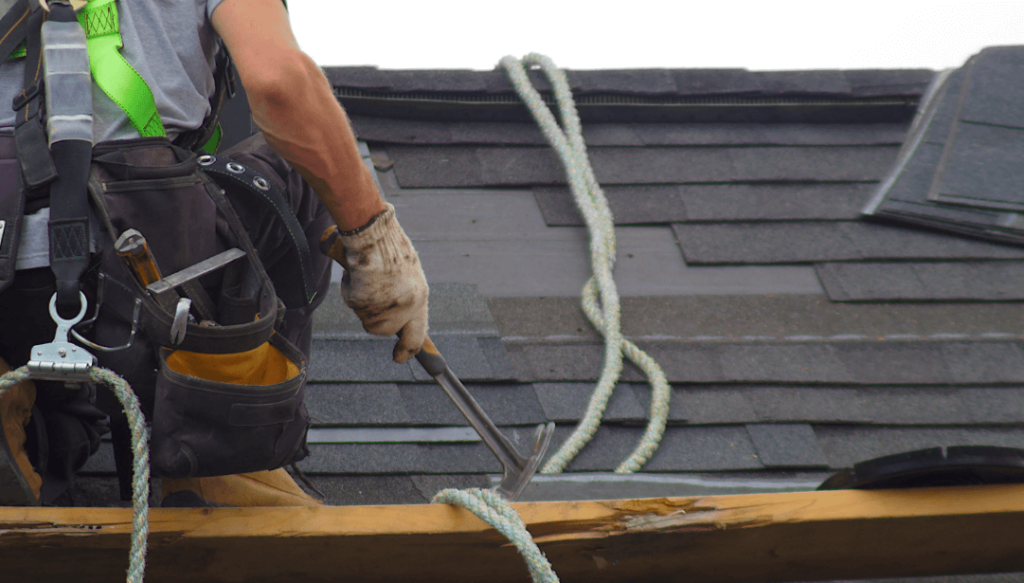
Roofing is one of the most hazardous professions, with fall accidents being a leading cause of injuries and fatalities. Implementing safety measures and using the right equipment minimizes risks and protects workers. In addition to physical safety gear, innovative technology like Pitch Gauge Roofing Software plays a pivotal role in preventing accidents. Here’s a comprehensive guide to the essential equipment and tools every roofer should use to avoid fall accidents.
1. Personal Fall Arrest Systems (PFAS)
A Personal Fall Arrest System is a foundational safety tool for roofers. It includes:
- Full-Body Harness: Distributes fall forces evenly to minimize injury risk.
- Lanyard or Lifeline: Shock-absorbing lanyards reduce the impact of a fall.
- Anchorage Point: A secure connection point supporting 5,000 pounds per worker.
Proper use of PFAS ensures that roofers remain safe even in hazardous conditions.
2. Guardrails and Safety Netting
- Guardrails: Provide a physical barrier along roof edges, making them essential for commercial and new construction projects.
- Safety Nets: Act as a secondary safety measure to catch workers in case of a fall.
3. Roof Edge Protection Systems
Temporary roof edge systems or parapet walls are crucial for creating a secure perimeter, reducing the risk of accidental falls.
4. Pitch Gauge Roofing Software
Technology plays a significant role in minimizing risks, and Pitch Gauge Roofing Software is a prime example.
- Measure Roof Pitch Safely: Pitch Gauge allows roofers to measure roof pitch accurately from their mobile device without climbing a ladder.
- Reduce Ladder Use: Roofers reduce their exposure to dangerous heights by eliminating unnecessary climbs.
- Boost Efficiency: The software provides precise measurements and reports, saving time while enhancing safety.
By integrating Pitch Gauge into your workflow, you can protect your team while maintaining professional accuracy.
5. Slip-Resistant Footwear
Proper footwear can significantly reduce slips and falls. Look for:
- Non-Slip Soles: Rubber soles designed for traction on wet or uneven surfaces.
- Durability: To withstand sharp roofing materials.
- Comfort: Padded soles to reduce fatigue during long hours on the job.
6. Roofing Ladders and Platforms
Safe access to the roof is essential. Use ladders equipped with:
- Stabilizers: Prevent tipping and enhance stability.
- Non-Slip Rungs: Provide secure footing even in damp conditions.
- Work Platforms: Offer stable, elevated surfaces for extended work areas.
7. Warning Line Systems
Warning line systems create a visible barrier around roof edges, clearly marking safe zones for workers. These systems are ideal for large, flat roofs without guardrails.
8. Weather-Appropriate Gear
Adapting to weather conditions minimizes risks. Equip your crew with:
- Rainproof Clothing: Improves grip and mobility during wet weather.
- Cold-Weather Gear: Prevents stiffness and discomfort that can affect performance.
- Sun Protection: Reduces glare and helps maintain focus in bright conditions.
9. Fall Detection Systems
Advanced safety devices, such as wearable fall detection sensors, alert team members in case of a fall. These systems ensure immediate response, reducing potential injuries.
10. Regular Training and Inspections
Even the best equipment is ineffective without proper training and regular maintenance.
- Safety Training: Ensure all workers know how to use fall protection systems and identify hazards.
- Equipment Inspections: Check safety gear regularly for wear and tear to ensure it’s in good working condition.
- Hazard Awareness: Encourage open communication about potential risks on the job site.
In Conclusion, Preventing fall accidents requires high-quality safety equipment, rigorous training, and innovative technology. Tools like Pitch Gauge Roofing Software provide an added layer of protection by reducing the need to climb ladders, significantly lowering the risk of falls. These tools ensure a safer, more efficient work environment when combined with personal protective equipment like PFAS and guardrails.
How do you prioritize safety in your roofing projects? Share your tips and experiences in the comments below!